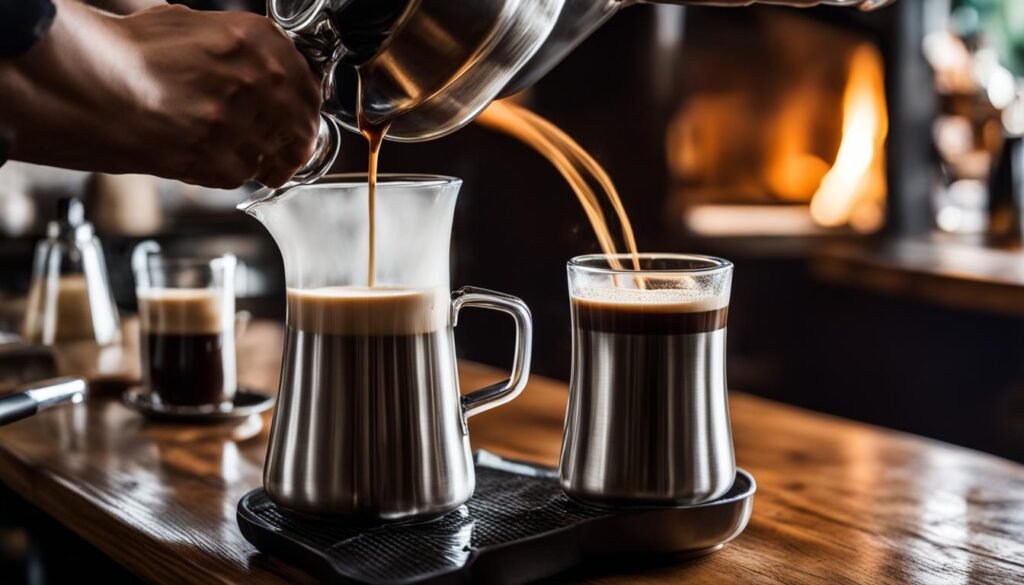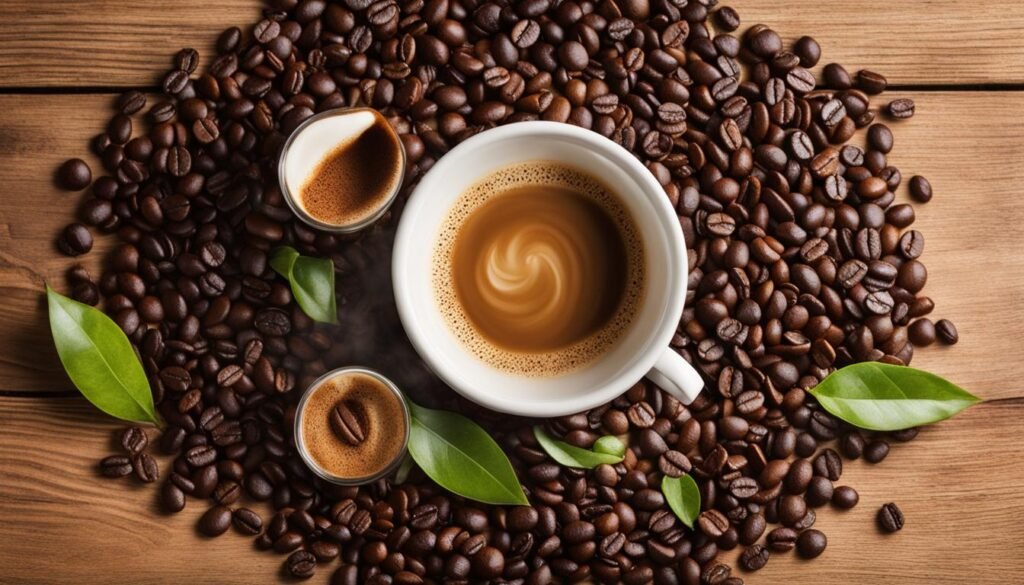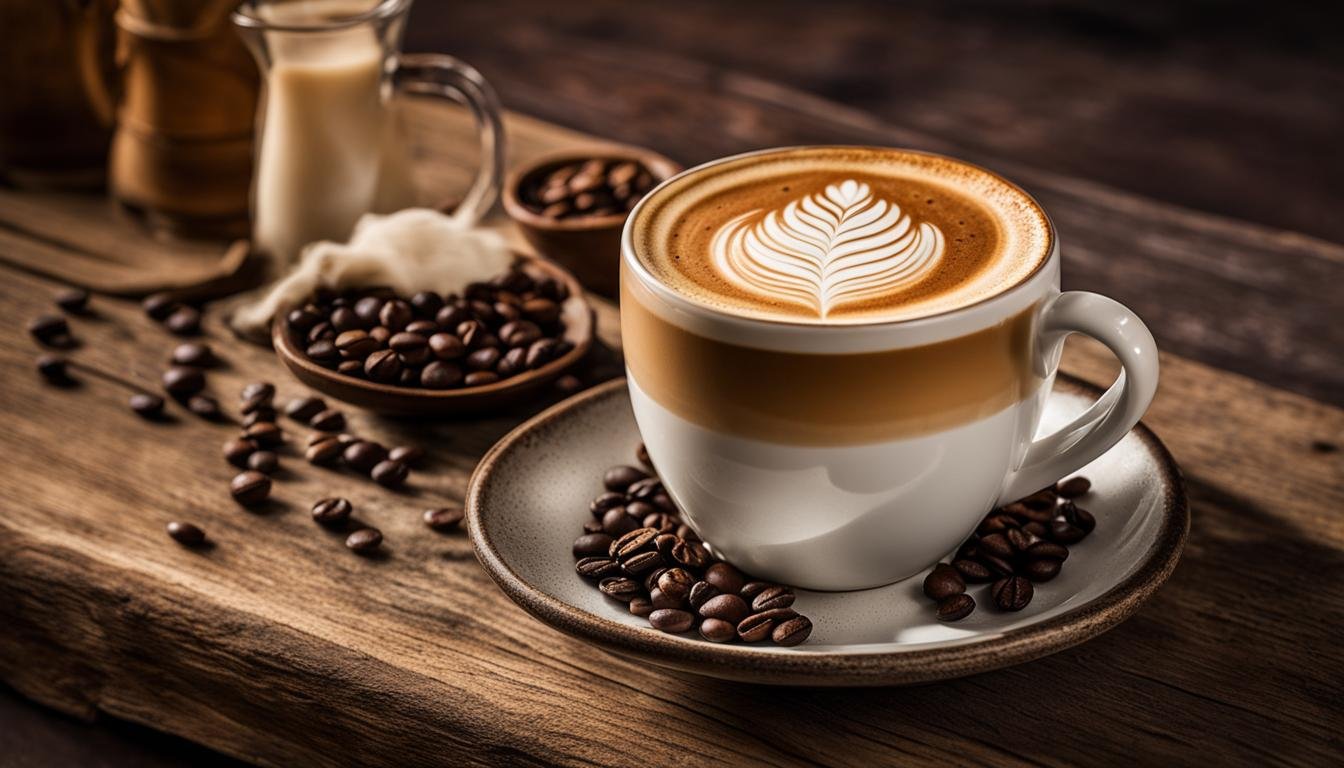The latte, a beloved beverage enjoyed by many, has an interesting history and cultural significance. It is a blend of espresso, steamed milk, and foam, but its origins can be traced back to Italy.
The Italians have long been known for their love of coffee, and in the 17th century, the combination of espresso and milk, known as “café au lait,” became popular among the Italian aristocracy. Over time, café au lait evolved into the latte that we know today.
Italian immigrants brought their coffee culture to America, and lattes gained popularity in the 1980s, especially in Seattle. Today, lattes can be found in coffee shops all over the world, making them a staple in the coffee industry.
Key Takeaways:
- The latte originated in Italy, where the combination of espresso and milk, known as café au lait, became popular in the 17th century.
- Italian immigrants brought the latte culture to America, and it gained popularity in the 1980s, particularly in Seattle.
- Lattes are now a staple in coffee shops worldwide.
- The latte is made with espresso, steamed milk, and foam.
- It can be customized with various flavors and alternative milks.
What is in a Latte? – What are Lattes Made of?
A latte is a popular coffee-based beverage that consists of two primary ingredients: espresso and milk. The espresso is a concentrated form of coffee made by forcing hot water through finely ground coffee beans under high pressure. This process extracts the rich flavors and aroma of the coffee, resulting in a strong and robust base for the latte.
The steamed milk is another crucial component of a latte. It adds a creamy and smooth texture to the drink, balancing out the intensity of the espresso. The milk is steamed using a steam wand, which creates small bubbles and aerates the milk, giving it a velvety consistency. The combination of the espresso and steamed milk creates a harmonious blend of flavors that is both satisfying and indulgent.
Additionally, lattes can be customized with various flavorings to add a unique twist to the classic recipe. Common flavorings include vanilla, caramel, hazelnut, and cinnamon. These additions enhance the taste profile of the latte, catering to different preferences and providing a touch of sweetness or spiciness.
Key ingredients of a latte:
- Espresso
- Milk
Optional ingredients for customization:
- Flavorings (e.g., vanilla, caramel, hazelnut, cinnamon)
The process of making a latte involves brewing the espresso, steaming the milk, and combining the two components in a cup. Baristas often take it a step further by creating latte art, where they use the milk to design intricate patterns on the surface of the latte. This adds an aesthetic appeal to the drink, making it visually pleasing and Instagram-worthy.
The History of the Latte – How are Lattes Made?

The latte has a fascinating history that can be traced back to Italy, the birthplace of coffee culture. Originally known as café au lait, meaning “coffee with milk,” the drink gained popularity among the Italian aristocracy in the 17th century. Over time, café au lait transformed into the latte that we know today. Italian immigrants brought their coffee traditions to America, and lattes started gaining traction in the 1960s. However, it wasn’t until the 1980s, particularly in Seattle, that lattes experienced a surge in popularity and became a staple in coffee shops worldwide.
Creating a latte involves a careful process. It begins with the extraction of espresso, a concentrated form of coffee made by forcing hot water through finely ground coffee beans under high pressure. The steamed milk is then poured over the espresso, creating a velvety texture and adding a creamy element to the beverage. Lattes can also be customized with different flavorings, such as vanilla or cinnamon, and milk alternatives, like soy or almond milk, can be used instead of cow’s milk to accommodate dietary preferences and restrictions.
The Evolution of Latte Making
- The first espresso machine was invented in 1884, but it wasn’t until the 1940s that Achille Gaggia’s lever-operated machine revolutionized the production of espresso.
- The steam wand, an essential tool for steaming milk, was introduced in the early 1900s but was initially used for heating milk rather than creating foam.
- In the 1950s, Lino Meiorin, the owner of The Caffe Mediterraneum, popularized the latte as we know it today.
- Since then, latte making has become an art form, with baristas showcasing their skills through latte art, where they create intricate designs on the surface of the beverage using the foamed milk.
The Latte’s Global Appeal
Today, lattes are enjoyed in coffee shops all around the world. Their popularity can be attributed to the milder and less bitter taste compared to straight espresso, making lattes appealing to a wide range of coffee enthusiasts. Additionally, the versatility of lattes allows for endless customization, making them suitable for individual preferences. The rich history and cultural significance of the latte, combined with its comforting and indulgent nature, have cemented its place as a beloved beverage in the ever-evolving coffee industry.
How to Make the Perfect Latte

If you’re a latte lover, you may have wondered how to make the perfect latte at home. Well, look no further! We’ve got you covered with a step-by-step guide to help you create a delicious and satisfying latte right in your own kitchen.
Gather Your Ingredients
First things first, gather all the necessary ingredients for your latte. You’ll need espresso, milk, a flavoring or sweetener of your choice (optional), and a hot paper cup. Make sure to have everything ready before you start the brewing process.
Brew the Espresso
The key to a great latte is a strong and flavorful espresso base. Brew two shots of espresso using your preferred method. Once the espresso is ready, pour it into the bottom of your cup. If you like flavored lattes, this is the perfect time to add your favorite flavoring, whether it’s vanilla, caramel, or something else. Stir well to combine.
Steam and Froth the Milk
In a steaming pitcher, pour the desired amount of milk. Use a steam wand to heat and froth the milk until it reaches a temperature of around 140-150 degrees Fahrenheit. Remember to tap the pitcher gently to remove any large bubbles and swirl it to keep the milk mixed.
Pour and Enjoy
Now comes the fun part! Slowly pour the steamed milk into the cup, using a circular motion. This will create layers of foam on top of the espresso. If you’re feeling adventurous, you can even try your hand at latte art by pouring the milk in specific patterns. Finally, grab a spoon, take a sip, and savor the rich and creamy goodness of your homemade latte!
With this easy-to-follow recipe, you can enjoy a perfect latte anytime, anywhere. So go ahead, unleash your inner barista, and indulge in the blissful experience of a freshly-made latte without leaving the comfort of your own home.
Why is the Latte so Popular?
The latte has become one of the most popular coffee beverages around the world. But what makes it so appealing? Let’s explore the factors that contribute to the latte’s widespread popularity.
Milder Flavor Profile
One of the reasons lattes are loved by many is their milder flavor profile. The combination of espresso and steamed milk creates a smoother and less bitter taste compared to other espresso-based drinks. This makes lattes more approachable and enjoyable for a wide range of coffee drinkers, including those who prefer a milder coffee experience.
Customization Options
Another factor that adds to the latte’s appeal is its versatility. Lattes can be customized with various flavorings, such as vanilla, caramel, or hazelnut, to suit individual preferences. This allows coffee lovers to personalize their drinks and create a unique flavor combination that suits their taste buds. Additionally, lattes can be made with alternative milks like soy, almond, or oat, catering to those with dietary restrictions or preferences.
Indulgent Experience
The latte offers a comforting and indulgent experience for coffee enthusiasts. The creamy texture of the steamed milk blends harmoniously with the rich flavor of espresso, creating a luxurious and satisfying beverage. Whether enjoyed as a morning pick-me-up or a cozy treat during the day, lattes provide a sense of comfort and indulgence that many people crave.
With its milder flavor, customization options, and indulgent experience, it’s no wonder that the latte has captured the hearts of coffee lovers worldwide. Whether you enjoy a classic latte or a creative variation, this beloved beverage continues to be a staple in coffee shops and a go-to choice for those seeking a delicious and satisfying coffee experience.
Origins and Development of Caffe Latte

The caffe latte, also known simply as a latte, has a fascinating history that can be traced back to the coffee culture of Italy. It originated as café au lait, a combination of espresso and milk enjoyed by the Italian aristocracy in the 17th century. Over time, this beverage evolved and gained recognition in Turin, Italy, where it was served in a glass and referred to as “latte di caffe.” Italian immigrants brought their coffee traditions to America, and it was in the 1960s that lattes began to grow in popularity in the United States.
The rise of coffeehouses and specialty coffee shops in the 21st century further contributed to the development and versatility of caffe lattes. Today, lattes can be enjoyed in various forms, with different milk alternatives and flavorings being introduced to cater to diverse tastes and dietary preferences.
The Influence of Coffee Culture
The origins and development of caffe latte are deeply intertwined with coffee culture. Italy, with its rich coffee heritage, served as the birthplace of this beloved beverage. The Italian tradition of savoring espresso with the addition of milk eventually made its way across Europe and into America, where it gained widespread recognition and became a staple in the coffee industry.
The Evolution of Caffe Latte
Throughout history, caffe latte has evolved to meet the changing tastes and preferences of coffee enthusiasts. Today, it continues to adapt and transform, with baristas and coffee shops offering a wide range of variations, from unique flavor combinations to latte art that adds a touch of creativity to each cup. The popularity of caffe lattes is a testament to their ability to bring together the bold flavors of espresso and the smoothness of milk, creating a harmonious and delightful coffee experience.
Conclusion
As we conclude our exploration of the latte, it is clear that this beloved beverage has captured the hearts and taste buds of people worldwide. The latte’s popularity can be attributed to its unique blend of espresso and milk, creating a smooth and creamy flavor that appeals to a wide range of coffee enthusiasts.
Not only is the latte delicious, but it also holds significant cultural significance. Originating from Italy, the birthplace of coffee culture, the latte carries with it a rich history and heritage. It has evolved over time, adapting to the preferences and tastes of different regions and individuals.
Today, lattes can be found in coffee shops across the globe, where skilled baristas masterfully create intricate latte art designs that add an aesthetic appeal to this already delightful beverage. Whether enjoyed as a morning pick-me-up or an indulgent treat, the latte has become an iconic symbol of the coffee industry, representing the harmonious marriage of coffee and milk that brings joy to millions every day.
FAQ
Where does latte come from?
The latte has its origins in Italy, where it was known as café au lait, meaning “coffee with milk.” It was a popular breakfast staple among the Italian aristocracy in the 17th century.
What are lattes made of?
Lattes are made primarily of espresso and steamed milk. The espresso is a concentrated form of coffee made by forcing hot water through finely ground coffee beans under high pressure, and the steamed milk is poured over the espresso to create a smooth and creamy texture.
How are lattes made?
Lattes are made by brewing espresso, steaming milk to a specific temperature, and combining the two components in a cup. The process involves pouring the espresso into the cup, frothing the milk using a steam wand, and then pouring the steamed milk into the cup in a circular motion.
What is the history of the latte?
The latte originated in Italy and evolved from the combination of espresso and milk known as café au lait. Italian immigrants brought their coffee culture to America, and lattes gained popularity in the 1980s, especially in Seattle, which further fueled their global popularity.
How do you make the perfect latte?
To make the perfect latte, you will need espresso, milk, a flavoring or sweetener (optional), and a hot cup. First, brew two shots of espresso and pour them into the cup. Then, froth the milk using a steam wand until it reaches a specific temperature. Gently tap the pitcher to eliminate large bubbles and pour the steamed milk into the cup in a circular motion, creating layers of foam on top of the espresso.
Why is the latte so popular?
Lattes have gained immense popularity due to their milder and less bitter taste compared to black coffee. Their versatility in terms of customization with flavorings and milk alternatives also contributes to their appeal. Lattes offer a comforting and indulgent experience with their creamy texture and rich flavor, making them a staple in coffee shops worldwide.
What is the origin and development of caffe latte?
The latte has its roots in Italy and coffee culture, with the traditional combination of espresso and milk dating back to the 17th century. The modern variation of the latte, known as caffe latte, gained recognition in the 19th century in Turin, Italy. Italian immigrants brought their coffee culture to America, where lattes further developed and diversified with various milk alternatives and flavors.
What is the cultural significance of the latte?
The latte has become a beloved beverage enjoyed by people worldwide, representing the intersection of coffee and milk in a harmonious blend. It has solidified its place in the coffee world and is considered a true icon of the industry. The latte’s popularity and cultural significance stem from its rich history, versatility, and comforting experience it offers to coffee enthusiasts.

Leave a Reply